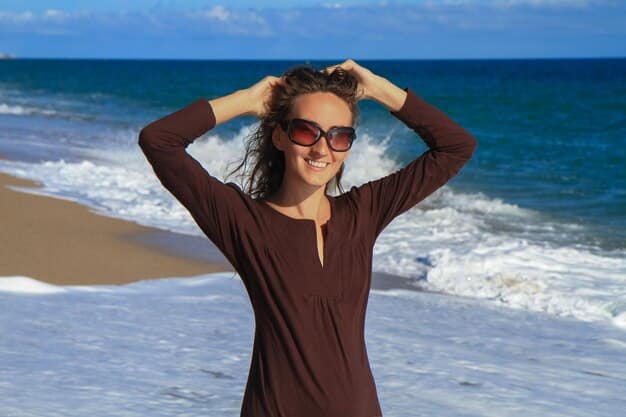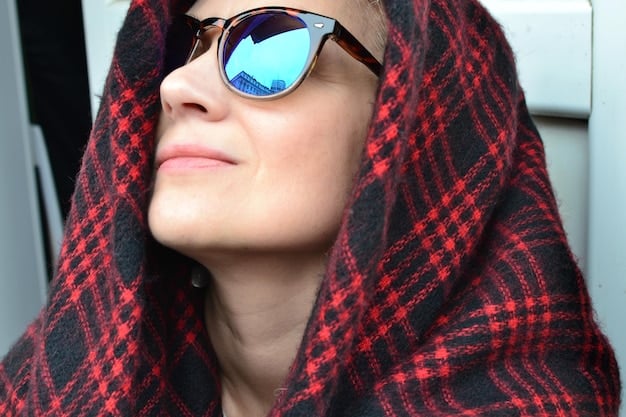Sun-Safe Style: Ultimate Guide to UV-Protective Clothing & Accessories This Summer

Achieving sun-safe style this summer involves strategically choosing UV-protective clothing and accessories that not only block harmful rays but also complement your aesthetic, ensuring both health and fashion are prioritized under the sun.
As summer approaches, the allure of sunshine calls us outdoors, but with it comes the undeniable need for protection against harmful ultraviolet (UV) radiation. This isn’t just about sunscreen anymore; embracing Sun-Safe Style: The Ultimate Guide to UV-Protective Clothing and Accessories This Summer means integrating smart, stylish choices into your wardrobe that actively shield you from the sun’s harsh rays while keeping you on-trend. From innovative fabrics to chic accessories, discover how to blend fashion with functionality for a truly radiant, and protected, season.
Understanding UPF: Your First Line of Defense
When it comes to sun protection in clothing, the term UPF (Ultraviolet Protection Factor) is paramount. It’s the apparel equivalent of SPF in sunscreen, indicating how effectively a fabric blocks ultraviolet radiation. A higher UPF rating means greater protection from both UVA and UVB rays, which are known to cause skin damage, premature aging, and increase the risk of skin cancer.
Unlike SPF, which only measures protection against UVB rays, UPF accounts for both UVA and UVB, offering a more comprehensive measure of protection when selecting garments. Wearing clothing with a good UPF rating means less reliance on continuous sunscreen reapplication across covered areas, providing consistent and reliable protection throughout your day in the sun.
The Difference Between UPF and SPF
Many people confuse UPF and SPF, but their distinctions are critical for comprehensive sun safety. While SPF (Sun Protection Factor) pertains exclusively to sunscreens and measures the level of protection against UVB rays, UPF offers a broader spectrum. Knowing this difference allows consumers to make informed choices, understanding that while sunscreen protects exposed skin, UPF clothing provides a physical barrier that remains effective as long as it’s worn.
- SPF (Sun Protection Factor): Measures how long it takes for UVB rays to redden skin protected by sunscreen compared to unprotected skin. Focuses on preventing sunburn.
- UPF (Ultraviolet Protection Factor): Measures how much of the sun’s UVA and UVB radiation is absorbed by the fabric. It assesses protection against both types of harmful rays.
- Comprehensive Coverage: UPF clothing offers a consistent barrier, unlike sunscreen, which needs regular reapplication and can be washed off by sweat or water.
The fibers, weave, color, and even the additives used in a fabric can significantly influence its UPF rating. Tightly woven fabrics, like denim or synthetic blends designed for sun protection, generally offer higher UPF values than loosely woven materials like sheer cotton or linen. Understanding these factors empowers consumers to choose clothing that provides truly effective sun shielding rather than just aesthetic appeal.
The choice of color also plays a role; darker colors tend to absorb more UV radiation than lighter ones, preventing rays from reaching the skin. However, in specially treated UPF garments, the fabric technology is the primary driver of protection, often making color less of a factor than in everyday clothing. Ultimately, integrating UPF-rated apparel into your summer wardrobe provides a convenient and often superior form of sun protection for covered areas.
Essential UV-Protective Clothing Pieces
Building a truly sun-safe wardrobe involves investing in key pieces that combine high UPF ratings with comfort and style. These aren’t just limited to activewear; the market has expanded to include fashionable options for every occasion, from beach days to city strolls. The goal is to maximize covered skin without compromising on breathability or aesthetics, ensuring you stay cool and protected.
Long-sleeved shirts and pants, often overlooked in summer fashion, are foundational elements of a truly sun-safe style. While initially counterintuitive for hot weather, modern UPF fabrics are engineered to be lightweight, moisture-wicking, and incredibly breathable, making them far more comfortable than traditional clothing that might trap heat. These garments provide continuous, broad-spectrum protection, alleviating the need for constant sunscreen reapplication on large areas of your body.
Must-Have Garments for Ultimate Sun Protection
Selecting the right garments transforms your summer experience, offering peace of mind along with style. The advancements in textile technology mean that sun-protective clothing no longer looks bulky or unfashionable. Instead, it integrates seamlessly into contemporary wardrobes, proving that protection can be chic.
- Long-Sleeved UPF Shirts: Ideal for active days outdoors or just casual wear. Look for lightweight, quick-drying fabrics that offer UPF 30+ or more. Many brands now offer stylish designs that don’t resemble traditional rash guards.
- Sun Pants/Leggings: Perfect for activities like hiking, fishing, or even just long walks. They provide excellent coverage for the legs, a common area for sun exposure. Fabrics are often breathable and offer stretch for comfort.
- Swimwear with UPF: Rash guards and full-body swimsuits are excellent options for prolonged water exposure. They prevent sunburn and reduce the overall UV burden on your skin, complementing sunscreen applied to exposed areas.
- Wraps and Scarves: Versatile and stylish, these can be draped over shoulders or used as head coverings for additional protection when needed. Choose those specifically labeled with UPF ratings for verified protection.
Beyond these primary items, consider specialized activewear for sports. For example, golf shirts, running tops, and cycling jerseys are now widely available with integrated UPF technology, allowing athletes to perform without constant worry about sun exposure. The key is to seek out reputable brands that clearly label their garments with UPF ratings, ensuring you’re getting genuine protection.
Ultimately, fully embracing sun-safe style means making intentional choices about the clothes you wear, recognizing them as a vital part of your sun protection strategy. By prioritizing UPF-rated garments, you’re not just adding layers; you’re adding an advanced shield against the sun’s damaging effects, allowing you to enjoy summer with greater confidence and comfort.
Stylish UV-Protective Accessories
While clothing forms the backbone of sun-safe style, accessories truly complete the look while adding crucial layers of protection. From head to toe, the right accessories can amplify your defense against UV rays, all while making a fashionable statement. These items are often the first line of defense for areas frequently exposed and often neglected, such as the face, neck, and hands.
Choosing accessories with UV protection means looking beyond superficial appeal to their functional benefits. A wide-brimmed hat, for example, is not merely a fashion statement but a fundamental barrier against direct sunlight on your face, ears, and neck. Similarly, sunglasses are indispensable for ocular health, protecting the sensitive structures of your eyes from UV-induced damage, which can lead to serious long-term conditions.

Top Accessories for Sun Protection and Style
Integrating sun-protective accessories into your daily wear doesn’t require sacrificing personal style. In fact, many brands now focus on creating accessories that are both highly effective and highly fashionable, offering a diverse range of designs, colors, and materials to suit any aesthetic.
- Wide-Brimmed Hats: Essential for protecting the face, neck, and ears. Look for hats with a brim of at least 3 inches all around and a UPF rating of 50+. Materials like tightly woven straw, canvas, or synthetic blends are effective.
- UV-Protective Sunglasses: Critical for eye health. Ensure your sunglasses block 99-100% of both UVA and UVB rays. The label should specify “UV400” or “100% UV protection.” Wraparound styles offer additional side protection.
- Sun Gloves/Arm Sleeves: Often overlooked, hands and arms are highly exposed. Sun gloves are great for driving or activities where hands are directly in the sun. Arm sleeves can be a convenient addition to short-sleeved shirts, offering flexible coverage.
- UV-Protective Umbrellas: Not just for rain, many umbrellas are designed with special coatings to block UV rays, offering a portable shade solution for prolonged outdoor activities or casual strolls.
When selecting accessories, consider factors like portability, comfort, and how well they integrate with your existing wardrobe. For instance, a lightweight, packable hat is ideal for travel, while versatile sun sleeves can be easily added or removed as sun exposure changes throughout the day. The aim is to create a multi-layered defense that works synergistically to keep you safe from harmful rays, regardless of your activity.
Ultimately, these accessories are more than just additions; they are active components of your sun-safe style strategy. By consciously choosing items that offer proven UV protection, you empower yourself to enjoy the summer season more fully, knowing you are well-equipped to face the sun while maintaining maximum style and comfort.
Choosing the Right Fabrics for Sun Safety
The secret to effective UV protection in clothing lies largely in the fabric itself. Not all materials offer the same level of sun blockage, and understanding the characteristics that contribute to high UPF ratings is crucial for making informed choices. Natural fibers, synthetic blends, and specially treated textiles each have their unique properties when it comes to shielding you from the sun’s rays.
The weave of a fabric is a primary determinant of its UPF. Tightly woven materials like denim, synthetic polyesters, or nylon leave fewer gaps for UV radiation to penetrate. In contrast, loosely woven fabrics such as typical linen or unbleached cotton allow more UV light to pass through, offering minimal inherent protection. This is why a simple cotton t-shirt, while comfortable, often provides a very low UPF, equivalent to an SPF of only about 5-7.
Fabric Characteristics for Superior UV Protection
Beyond the weave, several other factors influence a fabric’s ability to protect against UV radiation. Awareness of these characteristics empowers you to scrutinize garment labels and make selections that truly offer the sun defense you need, ensuring your sun-safe style isn’t just a label but a reality.
- Weave Density: As mentioned, a dense, tight weave is key. Look for fabrics that you can’t easily see through when held up to the light. These fabrics physically block UV rays more effectively.
- Fiber Type: Synthetic fibers like polyester and nylon are generally more effective at blocking UV rays than natural fibers like cotton, primarily due to their tighter molecular structure and inherent UV-absorbing properties. Some natural fibers, like bamboo or hemp, can offer good protection when tightly woven.
- Color: Darker colors tend to absorb more UV radiation than lighter colors, preventing it from reaching the skin. While special UPF treatments can make nearly any color protective, in untreated fabrics, darker hues offer a marginal advantage.
- Fabric Treatments: Many sun-protective garments are treated with UV-absorbing chemicals during the manufacturing process. These are often integrated into the fibers themselves, providing long-lasting protection that won’t wash out easily.
- Fabric Weight/Thickness: Generally, heavier and thicker fabrics offer more protection simply because there’s more material to block the rays. However, modern UPF fabrics are often lightweight yet highly protective due to advanced weaving and treatment technologies.
While a simple rule of thumb might suggest sticking to denim or heavy canvas for everyday protection, the true innovation in sun-safe style comes from highly engineered fabrics. These materials offer high UPF ratings while remaining lightweight, breathable, and comfortable even in hot weather. Brands specializing in sun-protective clothing often utilize blends that combine the best aspects of different fibers, ensuring optimal performance and wearability.
When shopping, always check the garment’s label for a specific UPF rating. This ensures you are purchasing an item designed and tested for its sun-protective qualities, rather than simply relying on assumptions about fabric type or color. This diligent approach helps you curate a summer wardrobe that is both stylish and genuinely protective against the sun’s harmful effects.
Beyond the Basics: Advanced UV Protection Strategies
Achieving truly comprehensive sun-safe style goes beyond simply choosing UPF-rated clothing and accessories. It involves a holistic approach that integrates behavioral strategies and technological advancements, ensuring you’re protected from all angles. While fabric is crucial, it’s just one piece of the larger sun safety puzzle that includes timing, shade, and supplemental products.
Understanding when and how the sun’s rays are strongest is a primary advanced strategy. The sun’s UV index, a measure of UV radiation intensity, varies throughout the day and year, as well as by geographic location. Being aware of peak UV hours, typically between 10 AM and 4 PM, allows you to plan your outdoor activities accordingly, minimizing exposure during the most dangerous times.
Implementing a Multi-Layered Sun Safety Approach
A multi-layered defense ensures you’re proactively managing your sun exposure rather than merely reacting to it. This approach combines physical barriers with smart planning, creating a robust shield against UV damage. For those committed to a genuinely sun-safe style, incorporating these advanced strategies should be second nature.
- Seeking Shade Strategically: Utilize natural shade (trees, buildings) or create your own with umbrellas or pop-up shelters. This significantly reduces your overall UV exposure, even when wearing protective clothing.
- Timing Outdoor Activities: Reschedule strenuous outdoor activities to early morning or late afternoon when the UV index is typically lower. This proactive measure lessens the intensity of your sun exposure.
- Broad-Spectrum Sunscreen Application: Apply a broad-spectrum sunscreen with an SPF of 30 or higher to all exposed skin, even when wearing UPF clothing. This is crucial for areas not covered by garments, such as the face, neck, and hands.
- Checking the UV Index: Many weather apps and websites provide real-time UV index information. Make it a habit to check the index before heading outdoors to inform your protection strategy for the day.
- Regular Skin Checks: While not a protection strategy itself, regular self-examinations and professional dermatological checks are vital for early detection of any sun-induced skin changes.
Furthermore, recognizing that UV rays can penetrate clouds and reflect off surfaces like water, sand, and snow highlights the need for constant vigilance. Even on an overcast day or during a breezy beach outing, the risk of UV exposure remains significant. This underscores why a comprehensive, multi-faceted approach to sun protection is indispensable.
Ultimately, adopting advanced UV protection strategies means weaving sun safety into the fabric of your lifestyle, not just your wardrobe. It’s about being informed, proactive, and consistent, ensuring that you can fully enjoy the summer outdoors while safeguarding your long-term skin health. This commitment to holistic protection is the hallmark of true sun-safe style.
Maintaining Your UV-Protective Garments
Once you’ve invested in UV-protective clothing and accessories, proper care is essential to maintain their effectiveness and longevity. Unlike regular clothing, some UPF fabrics have specific care instructions to preserve their sun-blocking properties and extend their life. Neglecting these guidelines can inadvertently reduce the garment’s protective capabilities, making your investment less effective over time.
The integrity of the fabric’s weave and any integrated UV-blocking treatments can be compromised by harsh washing methods, strong detergents, or excessive heat. While many UPF garments are designed for durability and ease of care, a little attention to detail in their maintenance will ensure they continue to provide optimal sun protection summer after summer. Just like any specialized apparel, they thrive with thoughtful handling.
Care Tips for Long-Lasting Sun Protection
Maximizing the lifespan and protective qualities of your sun-safe style pieces involves simple yet effective maintenance routines. These tips extend beyond basic laundry instructions to ensure the fabric’s inherent sun-blocking properties remain intact, safeguarding your health and optimizing your investment.
- Follow Care Labels: Always check the garment’s specific care label. While generalizations can be made, unique fabric blends or treatments might require particular washing temperatures or drying methods.
- Gentle Washing: Opt for a gentle cycle with cold or lukewarm water. Harsh washing can stretch or damage the fabric’s weave, creating microscopic gaps that allow more UV light through.
- Mild Detergent: Use a mild, pH-neutral detergent. Avoid harsh chemicals, bleach, or fabric softeners, as these can break down UV-absorbing chemicals in the fabric or leave residues that compromise protection.
- Air Dry When Possible: Line drying or laying flat to dry is ideal. High heat from a dryer can degrade elastic fibers and UV-protective treatments over time. If using a dryer, select a low heat setting.
- Avoid Stretching or Abrasion: While not a washing tip, be mindful of activities that could excessively stretch or abrade the fabric, as this can thin out the material and reduce its UPF rating.
Remember that the UPF rating of a garment can also decrease over time with repeated washing, wear, and exposure to chlorine or saltwater. While high-quality UPF clothing is designed to withstand these factors, vigilant care can significantly slow down this degradation. Regularly inspecting your favorite sun-protective pieces for signs of thinning, fading, or damage will help you determine when it might be time for a replacement.
Ultimately, treating your sun-protective garments with care is an integral part of maintaining your sun-safe style. It ensures that these specialized items continue to perform their crucial role in safeguarding your skin health, allowing you to enjoy the outdoors with confidence and peace of mind season after season.
Integrating Sun-Safe Style into Your Daily Life
Adopting a sun-safe style isn’t just about what you wear to the beach or on a lengthy outdoor adventure; it’s about making conscious choices that integrate seamlessly into your daily life. From your morning commute to a casual outdoor lunch, understanding how to apply sun protection principles every day is key to long-term skin health. It’s about proactive prevention, not just reactive measures.
The beauty of modern sun-protective clothing and accessories is their increasing versatility and aesthetic appeal. They are designed to fit into diverse settings, meaning you no longer have to sacrifice fashion for protection. This integration encourages consistent protection, making sun safety an effortless part of your routine rather than an occasional inconvenience.
Making Sun Safety a Seamless Part of Your Routine
Incorporating sun-protective elements into your everyday fashion choices extends your defense beyond obvious sunny scenarios. It’s about cultivating habits and selecting items that offer continuous benefits, ensuring your sun-safe style becomes an intuitive aspect of your daily existence.
- Commuting Smart: Even short periods in a car can lead to significant UV exposure through windows. Consider keeping a pair of UV-protective driving gloves or a long-sleeved UPF layer handy for drives.
- Outdoor Dining/Cafés: Look for outdoor seating options under umbrellas or awnings. Supplement your outfit with a UPF-rated wide-brimmed hat and sunglasses, even for a quick coffee break.
- Everyday Errands: Instead of a light t-shirt, opt for a UPF-rated polo or button-down shirt. For women, a stylish UPF scarf can serve multiple purposes, from protecting the neck and chest to adding a pop of color.
- Gardening/Yard Work: While often done at home, these activities expose you to significant sun. Donning a sturdy UPF work shirt, long pants, and a wide-brimmed hat is a simple step to protect yourself.
- Kids’ Playtime: Dress children in UPF swimwear and play clothes. Their skin is more sensitive, and establishing sun-safe habits early is crucial.
The notion that sun protection dampens daily spontaneity is largely outdated. With the wide array of fashionable and functional UPF apparel and accessories available, you can easily find items that match your personal style and activity level. Think of sun-safe choices not as limitations, but as an expansion of your wardrobe that prioritizes both well-being and elegance.
Ultimately, making sun-safe style a seamless part of your daily life is a commitment to your long-term health. It demonstrates an understanding that UV exposure is an ongoing concern, not just a summer vacation issue. By integrating these practices, you can confidently navigate your day, enjoying the benefits of natural light while remaining thoroughly protected.
| Key Point | Brief Description |
|---|---|
| 👕 UPF Clothing | Garments rated with Ultraviolet Protection Factor (UPF) block harmful UVA/UVB rays, offering reliable skin defense. |
| 🕶️ Essential Accessories | Wide-brimmed hats and UV-protective sunglasses are crucial for protecting delicate facial skin and eyes. |
| 🧶 Fabric Choices | Tightly woven synthetic fabrics (polyester, nylon) and treated natural fibers offer superior UV blocking. |
| 🧼 Garment Care | Gentle washing and air-drying preserve UPF ratings, extending the protective life of your sun-safe attire. |
Frequently Asked Questions About Sun-Safe Style
▼
UPF stands for Ultraviolet Protection Factor, indicating how much of the sun’s UVA and UVB radiation a fabric blocks. A UPF rating of 30 means the fabric allows 1/30th of UV radiation to pass through, effectively blocking 97% of rays.
▼
A UPF 30 rating is considered good for everyday sun protection, blocking 97% of UV rays. For prolonged exposure, particularly during peak sun hours or for those with sensitive skin, UPF 50+ is recommended as it blocks 98% or more of UV radiation.
▼
While any clothing offers some level of protection, regular clothes typically have a very low UPF (around 5-7), especially thin, light-colored, or loosely woven materials. This means significant UV radiation can still reach your skin, making specialized UPF clothing a much safer choice.
▼
Proper washing following care instructions (gentle cycle, mild detergent, air dry) helps maintain UPF ratings. Excessive stretching, harsh detergents, or high heat drying can degrade the fabric’s integrity and UV-blocking treatments, potentially reducing its effectiveness over time.
▼
Yes, UV-protective umbrellas designed with special coatings or tightly woven fabrics can be highly effective, often offering UPF 50+ protection. They provide a portable shade solution, significantly reducing direct sun exposure for prolonged outdoor activities or casual strolls.
Conclusion: Embrace Your Sun-Safe Summer
Embracing a sun-safe style this summer is more than a trend; it’s a vital step towards safeguarding your skin and overall health. By selectively choosing UV-protective clothing and accessories, understanding UPF ratings, and adopting smart daily practices, you can enjoy the warmth and vibrancy of the season without compromising your well-being. This guide has illuminated the path to stylish and effective sun protection, empowering you to make informed decisions that allow for confident and continuous outdoor enjoyment. Let this summer be a testament to how effortlessly fashion and personal health can coexist under the sun.





